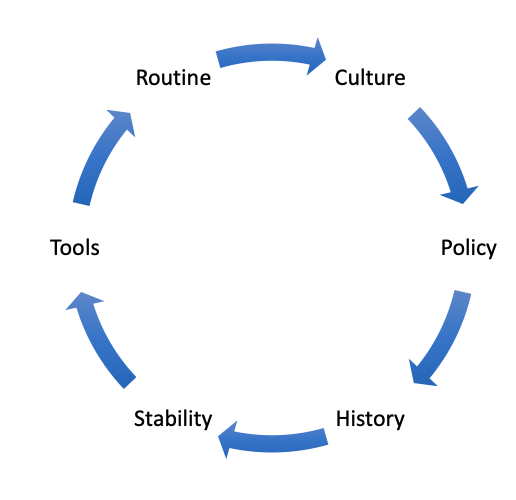
Distributed leadership, often referred to in the context of educational or learning-centered organizations, is an approach that describes leadership tasks and responsibilities being shared by those who have appropriate skills and experience within the organization.
This is different from the traditional model where leadership rests with a single or few people.
The ultimate aim of a distributed leadership model is to improve the quality and capacity of the leadership, helping an organization become more effective through empowerment.
In today’s article, we’ll be looking at Distributed Leadership we’ll be covering:
- What Is Distributed Leadership
- What Are the Key Concepts of Distributed Leadership?
- Why You Should Use Distributed Leadership
- How to Apply Distributed Leadership
- What Are the Advantages of Distributed Leadership?
- What Issues Are Associated With Distributed Leadership?
What Is Distributed Leadership
In the model of distributed Leadership, Leadership is separated from designated organization roles.
Instead, all individuals’ actions at every level are recognized as an integral part of the organization.
In other words, Leadership is about teamwork, and it breaks way from leader-follower ideas.
In a distributed leadership model, Leadership is distributed between all the individuals of the organization based on expertise and experience, making effective use of everyone’s skill set.
The model relies on a complete reconsideration of the usual power dynamics of organizations.
What Are the Key Concepts of Distributed Leadership?

Leadership
Leadership refers to the activities that relate to the core work of an organization. These activities are determined by some organizational members, and the objective is to influence knowledge, motivation, affect, or practices of other members of the organization. In the model of distributed Leadership, there are three key concepts, namely leader plus, practice, and situation. So let’s take a look at each one.
Leader plus.
This key concept proposes that leadership activity is distributed across many individuals in the organization. The focus is on leadership activity rather than on leadership roles. This leadership activity may include:
- Collaborated distribution – where two or more leaders who perform this leadership activity at the same time and place.
- Collective distribution which refers to performing leadership activities separately but in a particular order
- Co-ordinated distribution refers to leadership activities that are performed in a particular order.
Practice.
Practice refers to the result of the interaction between leaders and followers. This is key to distributed Leadership because it promotes distributed cognition, where understanding and thinking stems from interactions with other people, tools, and routines; it doesn’t occur individually.
Situation

Situation refers to all the material and social aspects that make up the environment of an organization, which includes
- Culture
- Policy
- History
- Staff stability
- Tools
- Routines
Tools and routines are two of the most important aspects of an organization. Tools are objects designed to enable some action, and in organizations, tools take many forms, and they’re meant to enable practice. Routines are patterns of action that are common in an organization, and they may or may not align with the tools. Both tools and routines take away some of the cognitive load required to accomplish tasks.
Why You Should Use Distributed Leadership
Distributed Leadership has many benefits; for one, it connects team members directly to the goals and values of the organization. This leaves the leader free of the burdening responsibilities of administration.
Distributed Leadership offers two main reasons to encourage use:
First, this new model of Leadership makes compelling changes. It encourages team members to stay and make efficient use of their skills. In other words, satisfaction and retention will improve with this model, and, as a result, achievements will improve as well because people will be encouraged and inspired by partners who are more focused than ever.
Second, the distributed leadership model relates closely to the overall goals of the organization. So, if your goal is to make everyone under your wing more democratic, the conditions of democratic life need to be reproduced within the organization, which includes everyone, not just leaders.
How to Apply Distributed Leadership
The application of distributed Leadership requires two major steps:
1/ Power Dynamics need to change
For the model of distributed Leadership to work, there must be a full-scale reconsideration of the power dynamics of your organization. Things must change! This group approach to strategy and goals is the core of distributed Leadership and it relies on more open communication between all the levels of the responsibility.
2/ Embrace Autonomy
Leaders must have a certain level of autonomy in each of their fields of responsibility. Understandably this autonomy needs to be earned because it must not foster inefficiency or ineffectiveness.
By providing autonomy, team members understand they’re accountable for their actions and results. In turn, they’re supported with resources to implement their strategies.
What Are the Advantages of Distributed Leadership?
Organizations are changing as industries grow and evolve. One person can’t have all the time, knowledge, and skills that the leadership position requires. In other words, one person can’t possibly lead all aspects of an organization. So, when you distribute Leadership, you’re increasing employee management and commitment because you’re creating a collective sense of responsibility and accountability.
Distributed Leadership also encourages the free-flow and sharing of ideas to generate new solutions; it also encourages more effective decision-making. Not to mention it helps to develop a greater sense of trust within the organization, it encourages teamwork on all levels, makes people have a more flexible and adaptable approach, it improves learning and the sharing of knowledge in all departments, and it encourages everyone to work together.
Issues associated With Distributed Leadership?
There are several key issues associated with Distributed Leadership:
Distributed Leadership may slow the decision-making process down because more perspectives need to be taken into account.
Silos can emerge if communication between groups is neglected, and the risk of a lack of strategic direction if departments are competitive with each other.
Organizations do not fully embrace the model, and the power dynamics fail to change sufficiently to foster a distributed model.
Summary
Distributed Leadership is a great way to create a more democratic environment in an organization, and it leads to incredible results. In essence, this approach allows leaders to make big changes and to make use of everyone’s talents, skills, and experiences for the betterment of the organization.
As ever, we’d love your feedback. Perhaps you’ve got experience of using this model in your own organization, or maybe you have questions about the model.
You can reach on Twitter or using the comments section below..
This article is part of our Management and Leadership guide.